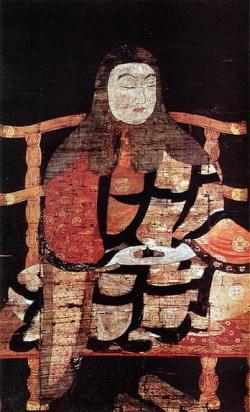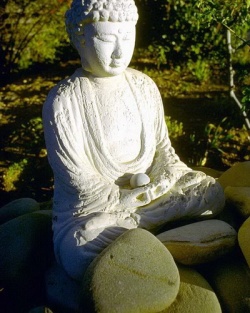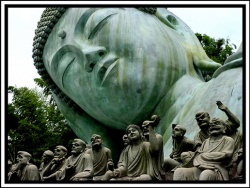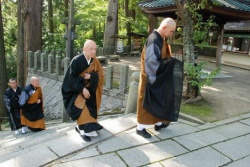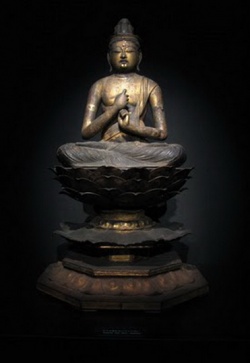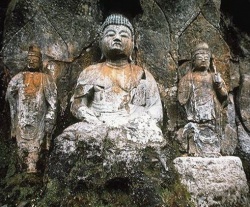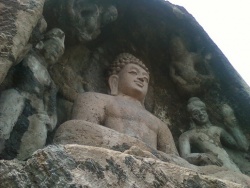Saichō
Saichō (最澄?, September 15, 767 – June 26, 822) was a Japanese Buddhist monk credited with founding the Tendai school in Japan, based around the Chinese Tiantai tradition he was exposed to during his trip to China beginning in 804. He founded the temple and headquarters of Tendai at Enryaku-ji on Mt. Hiei near Kyoto. He is also said to have been the first to bring tea to Japan. After his death, he was awarded the posthumous title of Dengyō Daishi (伝教大師).
Life
Early life
Saichō was born in the year 766 in the city of Ōmi, in present Shiga Prefecture, with the given name of Hirono. According to family tradition, Saicho's ancestors were descendants of Chinese Emperors of the Eastern Han Dynasty, however no positive evidence exists for this claim. However, the region where Saicho was born had a large Chinese-immigrant population, so Saicho likely did have Chinese ancestry.
During Saichō's time, the Buddhist temples in Japan were officially organized into a national network known as the Kokubunji system, and at the age of 13, Saichō became a disciple of one Gyōhyō (722-797, 行表)at the age of 13, then took tonsure as a novice monk at the age of 14 and was given the ordination name "Saichō". Gyōhyō in turn was a disciple of Dao-xuan (702-760, 道璿, Dōsen in Japanese), a prominent monk from China of the Tiantai school who had brought Northern School Chan teachings, Huayan teachings and the Fan Wang precepts to Japan in 736 and served as the "precept master" for ordination prior to the arrival of Ganjin.
By the age of 20, he undertook the full monastic precepts at Todaiji temple, thus becoming a fully ordained monk in the official temple system. A few months later he abruptly retreated to Mount Hiei for an intensive study and practice of Buddhism, though the exact reason for his departure remains unknown.Shortly after his retreat, he composed his Ganmon (願文?, "Saichō's Prayer") which included his personal vows to:
So long as I have not attained the stage where my six faculties are pure, I will not venture out into the world.
So long as I have not realized the absolute, I will not acquire any special skills or arts (e.g. medicine, divination, calligraphy, etc)
So long as I have not kept all the precepts purely, I will not participate in any lay donor's Buddhist meetings.
So long as I have not attained wisdom (lit. hannya 般若), I will not participate in worldly affairs unless it be to benefit others.
May any merit from my practice in the past, present and future be given not to me, but to all sentient beings so that they may attain supreme enlightenment.
In time, Saichō attracted other monks both on Mount Hiei, and from the Buddhist community in Nara, and a monastic community developed on Mount Hiei, which eventually became the temple of Enryakuji. Saichō was said to have carved an image of the Medicine Buddha and enshrined it.Additionally, he lit a lamp of oil before the Buddha and prayed that the lamp would never be extinguished. This lamp is now known as the Fumetsu no Hōtō (不滅の法灯?, "Inextinguishable Dharma Lamp") and has remain lit for 1,200 years.
The capital of Japan was moved from Nara to Nagaoka-kyō in 784, and then to Kyoto in 795. Because Mount Hiei was coincidentally located to the northeast of Kyoto, a direction considered dangerous according to Chinese geomancy, Saicho's presence on the mountain was thought to protect the new capital and brought him to the attention of the court. Saichō and his community on Mount Hiei also started to correspond and exchange ceremonies with the established communities in Nara, in addition to the monks at the Court, further enhancing his prestige.
One of Saicho's earliest supporters in the Court, was Wake no Hiroyo, who invited Saicho to give lectures at Takaosanji along with fourteen other eminent monks. Saicho was not the first to be invited, indicating that he was still relatively unknown in the Court, but still rising in prominence. Emperor Kammu consulted with Saichō about propagating his Buddhist teachings further, and to help bridge the traditional rivalry between the Hosso (Yogacara) and Sanron (Madhyamika) schools.Saichō petitioned to take a trip to China to study the original Tiantai. Permission was granted, and Saichō was allowed to cross the sea to Tang Dynasty China aboard the Kentoshi diplomatic mission ships.
Trip to China
The success of the Takaosanji lectures, plus Saicho's association with Wake no Hiroyo soon caught the attention of Emperor Kanmu who granted a petition by Saicho to journey to China to further study Tiantai doctrine in China, and bring back more texts. Saicho was expected to only remain in China for a short time however.
Saicho could read Chinese language, but was unable to speak it at all, thus he was allowed to bring a trusted disciple along named Gishin (義眞) who apparently could communicate. Gishin would later become one of the head monks of the Tendai order after Saicho.
Saicho was part of the four-ship diplomatic mission to Tang Dynasty China in 803. The ships were forced to turn back due to heavy winds, where they spent some time at Dazaifu. During this time, Saicho likely met another passenger named Kukai who was sent to China on a similar mission though he was expected to stay much longer.
When the ships set sail again, two sank during a heavy storm, but Saicho's ship arrived at the port of Ningbo, then known as Mingzhou (Chinese: 明州; pinyin: Míngzhōu; Wade–Giles: Ming-chou), in northern Zhejiang Province in 804. Shortly after arrival, permission was granted for Saicho and his party to travel to Mount Tiantai and was introduced to the 7th Patriarch of Tiantai Buddhism, named Tao-sui (Dào-suì 道邃) who became his primary teacher during his time in China. Tao-sui was instrumental in teaching Saicho about Tiantai methods of meditation, Tiantai monastic discipline and orthodox teachings. Saicho remained under this instruction for approximately 135 days.
Saicho spent the next several months copying various Buddhist works with the intention of bringing them back to Japan later. While some works existed in Japan already, Saicho felt that they suffered from copyist errors or other defects, and made fresh copies. Once the task was completed, Saicho and his party returned to Ningbo, but the ship was harbored in Fuzhou at the time, and would not return for 6 weeks.
During this time, Saicho went to Yuezhou (越州, modern-day Shaoxing) and sought out texts and information on esoteric Buddhism. The Tiantai school originally only utilized "mixed" (zōmitsu (雑密?)) ceremonial practices, but overtime esoteric Buddhism took on a greater role. By the time Saicho was in Japan a number of Tiantai Buddhist centers esoteric training, and both Saicho and Gishin received initiation at a temple in Yuezhou. However, it's unclear what transmission or transmissions(s) they received. Some evidence suggests that Saicho did not receive the dual (ryōbu (兩部?) transmissions of the Diamond Realm and the Womb Realm.Instead, it is thought he may have only received the Diamond Realm transmission, but the evidence is not conclusive one way or the other.
Finally, on the tenth day of the fifth month of 805, Saicho and his party returned to Ningbo and after compiling further bibliographies, boarded the ship back for Japan and arrived in Tsushima on the fifth day of the sixth month. Although Saicho only stayed in China for a total of 8 months, his return was eagerly awaited by the Court in Kyoto.
Founding of Tendai
On his return from China, Saichō worked hard to win recognition from the court and "in the first month of 806, Saichō’s Tendai Lotus school (Tendai-hokke-shū 天台法華宗) won official recognition when the court of the ailing emperor Kanmu issued another edict, this one permitting two annual ordinands (nenbundosha) for Saichō’s new school on Mt. Hiei. This edict states that, following Saichō’s request, the ordinands would be divided between two curricula: the shanagō course, centering on the study of the Mahavairocana Sūtra (this was the Mikkyō curriculum, shana being the abbreviation for Birushana, the Japanese transliteration of Vairocana), and the shikangō course, based on the study of the Mo-ho chih-kuan, the seminal work of the T’ien-t’ai patriarch Chih-i 智顗 (538–597) (this was the Tendai curriculum, shikan being the Japanese reading of Chih-i’s central practice of chih-kuan [cessation and contemplation]) (Kenkairon engi, DZ 1, pp. 294–96). Thus from its very inception the Tendai Lotus school was equally based on Mikkyō and T’ien-t’ai. It was as a subdivision of Saichō’s new school that Mikkyō first received the official acknowledgment of the imperial court and became a proper subject of study in Japanese Buddhism."
"[I]n 813 Saichō composed the Ehyō tendaishū (DZ 1, pp. 343–66), which argues that the principal Buddhist masters of China and Korea all relied on T’ien-t’ai doctrine in composing their own works. By identifying numerous references to and quotes from T’ient’ai treatises in the works of Chi-tsang 吉蔵 of the San-lun 三論 school, Chih-chou of the Fa-hsiang 法相 school, Fa-tsang of the Huayen 華嚴 school, I-hsing of Mikkyō, and other prominent teachers, Saichō asserted that T’ien-t’ai formed the foundation for all major Buddhist schools in East Asia."
Previous to Saichō, all monastic ordinations took place at Tōdai-ji temple under the ancient Vinaya code, but Saichō intended to found his school as a strictly Mahayana institution and ordain monks using the Bodhisattva Vows only. Despite intense opposition from the traditional Buddhist schools in Nara, his request was granted by Emperor Saga in 822, several days after Saichō died. This was the fruit of years of effort and a formal debate."
Decline and Death
By 822, Saichō petitioned the court to allow the monks at Mount Hiei to ordain under the Bodhisattva Precepts rather than the traditional ordination system, arguing that his community would be a purely Mahayana, not Hinayana one.This was met with strong protest by the Buddhist establishment who supported the kokubunji system, and lodged a protest. Saichō composed the Kenkairon (顕戒論?, "A Clarification of the Precepts"), which stressed the significance of the Bodhisattva Precepts, but his request was still rejected until 7 days after his death at the age of 56.
Relationship with Kūkai
Saichō traveled to China along with a number of other young monks, one of whom was named Kūkai. Saichō befriended him during his trip to China who traveled with him going and coming. This turned out to be pivotal to the future development of Buddhism.
"During the last month of his stay on Chinese soil, while awaiting the arrival of his ship at the port city of Ming-chou, Saichō traveled to Yüeh-chou to collect additional Buddhist texts. At Lung-hsing ssu 龍興寺 Saichō chanced to meet the priest Shun-hsiao"
, and likewise returned with esoteric (tantric) Buddhist texts. Saicho was entranced with the new material and wanted to learn more. On the trip back he found that Kukai had studied these teachings in depth and had an entire library of tantric materials.
This friendship would influence the future of Japanese Tendai.
“ "SAICHŌ 最澄 AND KŪKAI 空海 are renowned as the founders, respectively, of the Japanese Tendai and Shingon schools, both of which grew into influential institutions of continuing importance even today. The two figures cooperated, moreover, in an effort to transplant the seed of esoteric Buddhism (mikkyō) to the cultural soil of Japan. Saichō, for example, prepared the way for Kūkai—still largely unrecognized after his return from T’ang China—to perform the Mikkyō initiation ritual of abhiṣeka (kanjō 灌頂) for the high priests of the Nara Buddhist establishment and the dignitaries of the imperial" Heian court." ”
It was Saichō who performed the abhiṣeka, or initiatory ritual, for the court. "Saichō also endorsed the court’s bequest to Kūkai of the mountain temple of Takaosan-ji northwest of Kyoto as the first center for Kūkai’s Shingon school. Kūkai, in turn, responded to Saichō’s wish to incorporate Mikkyō into the eclectic system of Tendai by training Saichō and his disciples in the esoteric Buddhist rituals and by lending Saichō various Mikkyō texts that he had brought with him from China."
Exoteric Syncretic tradition versus esotericism
Thus esoteric Buddhism became an important aspect of the Tendai school, which was primarily focused on the Lotus Sutra. "Chinese T'ien-t'ai had been a syncretistic tradition, particularly at the T'ien-t'ai Yu-ch'uan monastery. Chinese monks had been interested in Ch'an and Esoteric Buddhism as well as in the Ssu-fen la and Fan wang precepts. Saicho inherited this tradition, but developed certain aspects of it in innovative ways. For example, Saicho considered Esoteric Buddhism to be essentially the same as Tendai (enmitsu itchi) and thus awarded Esoteric Buddhism a more central place in the Tendai tradition than it had been given by most Chinese monks. Like Kūkai, Saichō emphasized the importance of striving for enlightenment as an immediate goal to be attained in this existence (sokushin-jōbutsu). Tendai and Esoteric practices, he felt, provided a direct path (jikido) to enlightenment, whereas the teachings of the Nara schools required aeons to bring the practitioner to enlightenment.
However,
During the years that Saichō studied Esoteric Buddhism (from 805-815), more than half of the Tendai yearly ordinands left Mount Hiei. Many of them defected to the Hosso school; others departed in order to study Esoteric Buddhism with Kūkai or to support their ailing mothers. It became clear that if Tendai were to survive, Saichō would have to retain many more of his students on Mount Hiei.
Moreover, Saichō began to realize that his own idea of "enmitsu itchi" was not exactly shared by the Esoteric Shingon school, and especially its founder Kūkai (Kōbō Daishi).
Ryuichi Abe writes: "...what makes the relationship between Saichō and Kūkai decisive in Japanese Buddhist history is not so much their cooperation as the manner in which it came to an end. Their alliance began to deteriorate when Saichō, after receiving abhiseka from Kūkai, hurried back to Mt. Hiei, where the work of laying the foundation of the new Tendai school awaited him. Saichō continued to study and copy Mikkyō texts borrowed from Kūkai, but despite Kūkai’s repeated requests he did not return to Takaosan-ji to resume his studies. Their rapport finally terminated when Kūkai harshly condemned Saichō’s approach to Mikkyō as a transgression of the esoteric precept of samaya [the promise to keep the oral/esoteric teachings private], and Saichō retorted by denouncing Kūkai’s manner of instruction "Thus it was Mikkyō that brought Saichō and Kūkai together; it was also Mikkyō that drove them apart. The break between Saichō and Kūkai left a long-lasting legacy in the Tendai and Shingon schools, whose complex relationship, constantly oscillating between affiliation and rivalry, shaped the contours of Buddhist history in the Heian period."
During the last five or six years of his life, Saicho strove to secure the place of Tendai within Japanese Buddhism, and in the process composed almost all of his major works.
"In 816, Saichō added a new introduction to the work. This introduction chides Sanron, Hossō, and Kegon—the leading schools of Nara Buddhism—for ignoring the influence of T’ien-t’ai on the works of their Chinese patriarchs, but its criticism of Shingon stands out: “The esoteric Shingon Buddhist, the newcomer, went so far as to deny the validity of transmission through writing (hitsuju Ù4)” (DZ 3, p. 344). In this comment Saichō denounced Kūkai and Shingon for their approach to Buddhism and religious study."
Saichō's late life criticisms were ignored by his own leading disciples, and the Tendai Sect would continue to teach Mikkyō and Shikangō (Lotus). Saichō’s public condemnation of Kūkai would later form the Seeds for some of the Criticisms leveled by the founder of the Nichiren Sect, Nichiren, who would cite that work in his own debates.
Saichō was also an author. He wrote a number of texts, the main ones include:
Shōgon Jikkyō (照権実鏡?) (817)
Sange Gakushō Shiki (山家学生式?) (818-819)
Shugo Kokkai Shō (守護国界章?) (818)
Kenkairon (顕戒論?) (820)
